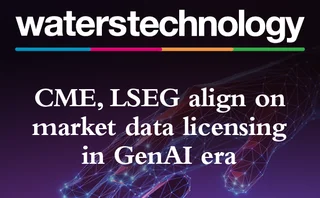Golden Copy: Identification and Verification
Legal entity identifier backers turn their focus to quality, but volume is still an issue
This week, Richard Berner, director of the Office of Financial Research (OFR), the unit of the US Treasury that promotes adoption of standards in the financial industry, including the legal entity identifier (LEI), made a statement that the LEI is an example of how public-private cooperation produces better standards.
To that end, the Global Legal Entity Identifier Foundation (GLEIF), the body that administers LEIs worldwide, has just launched a data challenge facility that lets interested parties verify, and, when needed, update LEI records and their related reference data.
GLEIF's action shows it is listening to the methods Berner and his colleagues at the OFR are advocating, or at least using these methods of its own volition. Although the OFR has been supportive of GLEIF's efforts, with its chief counsel serving as GLEIF's first chairman, and continued participation in GLEIF's executive committee, a paper by Berner's colleague, Cornelius Crowley, chief data officer at OFR, notes that LEI adoption is still uneven, more so in markets where the LEI is not required.
For instance, from the total of 451,850 LEIs registered as of July 15, about 130,000 are from the US and Canada, about 154,000 collectively from the UK, France, Germany, Italy and Sweden; and about 12,000 collectively from Japan, Australia and Singapore. The other 155,000 or so LEIs are spread out worldwide in pockets of double- or even single-digit numbers in numerous countries, some countries with 100 to 300 each, and a few others with several hundred each, namely the BRIC countries (Brazil, Russia, India and China).
Crowley writes that the quality of existing LEI data is high, so while a data challenge facility designed to raise the quality of LEI data can't hurt, the GLEIF's cause might be better served by promoting more registrations, to exponentially raise the numbers across the board, whether that's in highly developed markets with multiple thousands of registrations, or small markets with just hundreds or less.
GLEIF's verification effort can have value, however, if it succeeds in addressing a gap, pointed out by consultant Allan Grody of Financial InterGroup, between the registered LEIs and LEIs that have actually been validated, which are only about 70% of the registrations, depending on the market.
Only users who have a paid subscription or are part of a corporate subscription are able to print or copy content.
To access these options, along with all other subscription benefits, please contact info@waterstechnology.com or view our subscription options here: https://subscriptions.waterstechnology.com/subscribe
You are currently unable to print this content. Please contact info@waterstechnology.com to find out more.
You are currently unable to copy this content. Please contact info@waterstechnology.com to find out more.
Copyright Infopro Digital Limited. All rights reserved.
As outlined in our terms and conditions, https://www.infopro-digital.com/terms-and-conditions/subscriptions/ (point 2.4), printing is limited to a single copy.
If you would like to purchase additional rights please email info@waterstechnology.com
Copyright Infopro Digital Limited. All rights reserved.
You may share this content using our article tools. As outlined in our terms and conditions, https://www.infopro-digital.com/terms-and-conditions/subscriptions/ (clause 2.4), an Authorised User may only make one copy of the materials for their own personal use. You must also comply with the restrictions in clause 2.5.
If you would like to purchase additional rights please email info@waterstechnology.com
More on Trading Tech
Will overnight trading in equity markets expand next year? It’s complicated.
The potential for expanded overnight trading in US equity markets sparked debate this year, whether people liked it or not.
WatersTechnology latest edition
Check out our latest edition, plus more than 13 years of our best content.
The total portfolio approach gains momentum: Building the right tech foundation for success
The rationale for the TPA, and the crucial role technology plays in enabling such an approach
Google, CME say they’ve proved cloud can support HFT—now what?
After demonstrating in September that ultra-low-latency trading can be facilitated in the cloud, the exchange and tech giant are hoping to see barriers to entry come down.
Institutional priorities in multi-asset investing
Private markets, broader exposures and the race for integration
BlackRock and AccessFintech partner, LSEG collabs with OpenAI, Apex launches Pisces service, and more
The Waters Cooler: CJC launches MDC service, Centreon secures Sixth Street investment, UK bond CT update, and more in this week’s news roundup.
TCB Data-Broadhead pairing highlights challenges of market data management
Waters Wrap: The vendors are hoping that blending TCB’s reporting infrastructure with Broadhead’s DLT-backed digital contract and auditing engine will be the cure for data rights management.
Robeco tests credit tool built in Bloomberg’s Python platform
This follows the asset manager’s participation in Bloomberg’s Code Crunch hackathon in Singapore, alongside other firms including LGT Investment Bank and university students.








